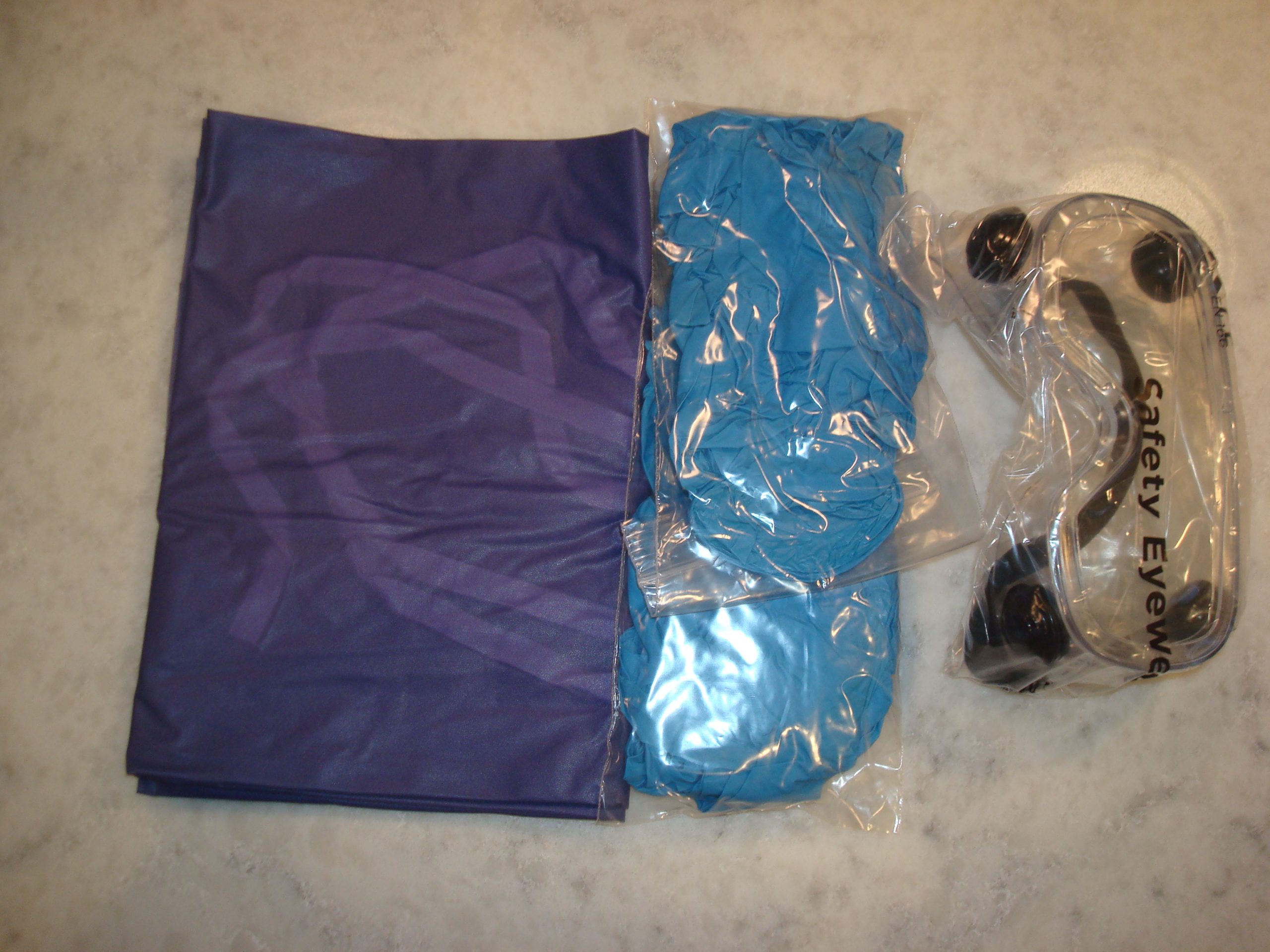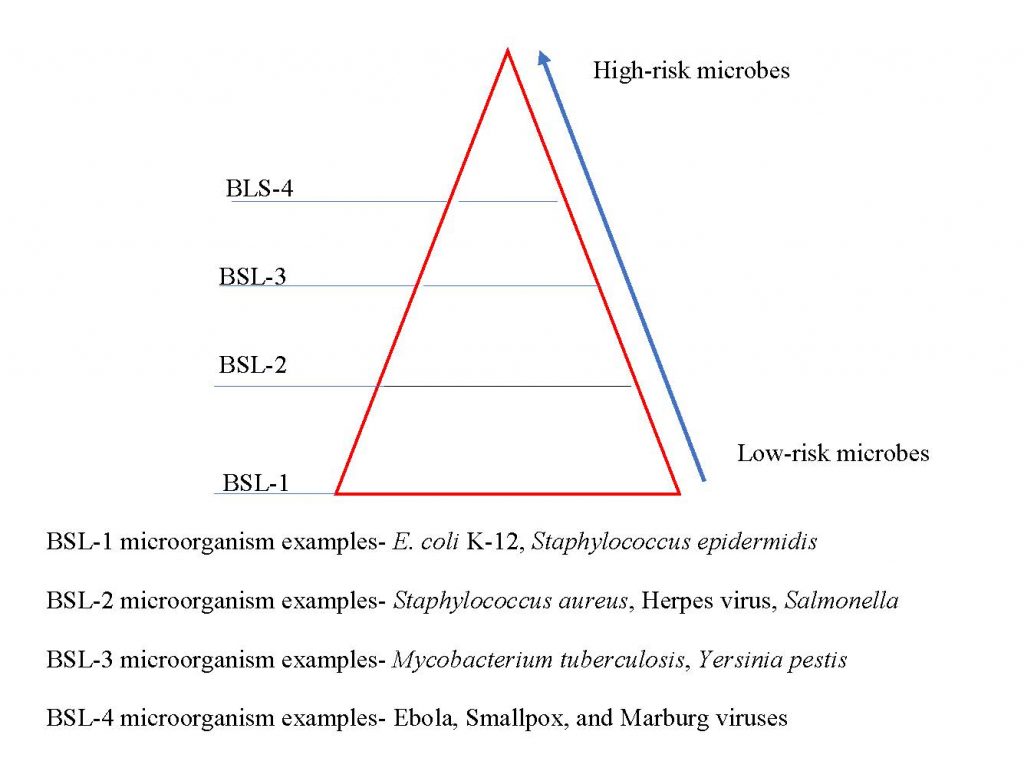SAFETY

Microorganisms are essential to life on earth. They provide many benefits to our planet and us. Nevertheless, they may cause disease in living organisms. Thus, microbiology laboratory exercises are not without risks. These risks are minimized when you are aware of the rules of laboratory safety and make them a habit. If you regularly follow the rules, you should perform the lab exercises correctly and enjoy the experience!
Some individuals are at increased risk of infection. These include those with diabetes, undergoing chemotherapy, who are pregnant, taking immunosuppressive drugs (such as corticosteroids), who are HIV positive, and/or those with autoimmune disease. If you have any reason to suspect you are at higher risk of infection than the average student, you should discuss the situation with your physician and your instructor.
GENERAL SAFETY AND ORGANIZATION
Working alone while performing microbiology laboratory exercises is strongly discouraged but may be difficult to avoid in online courses. When working alone, keep a phone nearby and have someone to call if an accident occurs.
Be prepared to devote your full attention to each laboratory exercise. Distractions or interruptions can lead to accidents. Turn your cell phone to silent or vibrate to limit distractions.
Never leave your laboratory exercise unattended. Monitor the laboratory exercise at all times.
Read the laboratory exercise thoroughly before you begin. Laboratory exercises in this course contain multiple steps and reading through the entire exercise will prepare you and help you to work more efficiently, safely, and eliminate mistakes due to lack of planning. If you have any doubt as to how to perform an exercise safely, call, text, or email your instructor before continuing with the exercise.
Assemble all laboratory equipment and materials before you begin the laboratory exercise.
Clear your workspace of all objects except for what is required for the laboratory exercise; remove all food and drink from the area. Do not eat, drink, chew gum, or smoke while performing laboratory exercises.
Even with precautions, accidental contact between chemicals/microorganisms and clothing may occur. Washing your clothing after the completion of laboratory exercise is recommended.
Never perform any laboratory exercise while under the influence of alcohol or drugs.
Wash all non-disposable laboratory plastic ware with soap and water after the activity.
Put all laboratory equipment, materials, and chemicals back into the lab kit box for storage.
KIDS AND PETS
The microbiology laboratory exercises in this course are designed to be performed in a non-traditional laboratory setting, your home. Safety precautions must be followed to ensure that the lab materials do not cause harm to you or other members of your household. Only you can assess all the potential hazards of your at home laboratory setting, so it is your responsibility to take the necessary precautions. The danger in performing laboratory exercises at home is that young children or pets may find and want to play with laboratory equipment or materials. Many pets have an acute sense of smell and may be attracted to something in the laboratory kit.
If possible, set up and perform laboratory activities when children are not present. Be sure to secure pets for their own safety.
Chemicals, SPILLS, BROKEN GLASS, and Candles
Chemicals
Before you begin the experiment, look at the labels of all the chemicals you will be using. If you have any questions or concerns about the proper handling of these chemicals, read the Safety Data Sheet of the chemical in question. These sheets list the dangers, storage requirements, exposure treatment, and disposal instruction for the chemical. The Safety Data Sheet (SDS) for every chemical in the kit can be found on the Carolina web https://www.carolina.com/teacher-resources/msds-material-safety-data-sheets/10857.co?mCat=. If a spill occurs, consult the SDS to determine how to clean up the spill. Most laboratory exercises are designed to avoid use of dangerous and hazardous chemicals. However, some exercises require these chemicals and thus necessitate additional safety precautions. These special precautions will be identified using standard pictograms that identify physical and chemical hazards on SDS and labels.

Flammable materials. These usually include alcohol or other flammable solvents. Wear safety eye wear, chemical-resistant gloves, and a chemical-resistant apron. Keep all ignition sources such as flames, pilot lights, or heat sources away from the location of the chemical. Keep the lid on the flammable liquid bottle at all times to reduce fumes and spills.

Corrosive materials. These usually include acids or bases. Wear safety goggles, chemical-resistant gloves, and a chemical-resistant apron. Use these materials near running water that can also serve as a safety eye wash or shower if any corrosive material makes contact with your skin or eyes.
Consult your physician if you are pregnant, allergic to chemicals, or have other medical conditions that may require additional protective measures.
Always wear safety goggles, gloves, and apron when handling chemicals.
Always put lids back onto chemical bottles immediately after use.
Never ingest or taste chemicals. If this occurs, seek immediate help. Call Poison Control at 800‐222‐1222 or dial 911.
Never use any chemical in the laboratory kit for any purpose other than the laboratory activity.
Never return dispensed chemicals to their original containers or place chemicals in an unmarked container.
Chemical Spills
If a spill occurs, most chemicals can be cleaned up immediately using paper towels and then thoroughly rinsing the spill area with water. Paper towels can then be disposed of in the trash.
If a chemical splashes into your eyes, immediately rinse your eyes with water for at least 15 minutes. A kitchen sink sprayer or bathroom shower can be used as an eye wash. Then seek a medical professional for additional advice and treatment.
If a corrosive chemical splashes onto your skin, immediately wash the area with cool water for at least 15 minutes. Then seek a medical professional for additional advice and treatment. A kitchen sink sprayer or bathroom shower can be used as a safety shower.
Culture Spills
In the event of a spilled microbial culture, cover the spill with paper towels saturated with 10% bleach and allow to sit for at least 20 minutes. After 20 minutes, throw the paper towels in the trash. If a microbial culture splashes onto your skin, wipe it off with a paper towel saturated with 70% isopropyl alcohol. Then wash the area thoroughly with soap and water.
Broken Glass
Never pick up broken glassware with your hands. Use a broom and dustpan to pick up broken glassware. Place glass into an intermediate container before disposing into a garbage can.
Candles and Flames
If a candle is used during the laboratory exercise, the potential for a fire exists. Keep all flammable and combustible materials away from the flame, including paper, books, and paper towels.
Never leave a heat source unattended. If there is a fire, evacuate the room immediately and dial 911.
Know where your fire extinguisher is if you own one. If you do not own a fire extinguisher, they can be purchased at most home improvement or grocery stores.
SELECTING YOUR WORK AREA
Identify a work area (nonporous surface that will not be damaged by bleach) in a well-ventilated area where all laboratory exercises will be performed. Avoid working in areas with carpets or rugs. Ideally, your lab bench be located close to a kitchen or bathroom. Safety showers are used if someone is exposed to a large quantity of microorganisms, or if a hazardous chemical is spilled on a person and that person is unable to rinse it off thoroughly in a sink.
A standard home shower sufficiently serves as a safety shower should the need arise. Stand under the flow of water while wearing the contaminated clothing for at least 20 minutes.
An eyewash is used if your eyes are exposed to a microorganism, or if a chemical is splashed into your eyes are face. Use the nearest sink and flush your eyes or face with cool water for at least 20 minutes. If the sink has a sprayer, use it to rinse your eyes or face while making sure the water drains into the sink. Any hazardous chemicals in the lab kit have been limited to small volumes to reduce the possibility of needing a safety shower or eyewash.
Proper ATTIRE
ALWAYS wear appropriate attire when performing laboratory activities.
- Closed-toe shoes that are solid, not made of cloth, not perforated (no ballet flats) must be worn when performing laboratory exercises.
- To reduce exposure of your body, wear a long-sleeved shirt under your apron. Wear long pants, no skin can be showing, so you may have to wear socks with your shoes. A skirt can be worn but it must fit close to the body and again no skin can be showing.
- Long hair should be fastened and dangling jewelry or loose hanging garments or sleeves should not be worn. They may contaminate microbial cultures.
- Avoid loose or dangling clothing or jewelry that could catch on objects or interfere with the lab exercise.
PERSONAL PROTECTIVE EQUIPMENT (Googles, Gloves, Apron)
Wearing Personal Protective Equipment (PPE) is required in college science laboratories and is also required when performing laboratory exercises at home.
Safety Goggles
Wear safety goggles to protect against eye injury. Any time chemicals, preserved or living microorganisms, glassware, or heat are utilized in a laboratory experiment, safety goggles are required. Be sure to wear safety goggles when taking photos of your lab results. Under some conditions, safety goggles will begin to fog up. If this occurs, step away and wash your hands before cleaning your eye wear.
Watch the following video on safety goggles
Gloves
Wash your hands before putting gloves on and after removing them. Cover cuts or open wounds before putting on (donning) gloves. Wear gloves to protect your hands when you are performing lab exercises or taking photos of your lab results. If punctured or torn, gloves should be disposed of immediately. To limit contamination, removed gloves should not be reused.
Watch the following video on gloves
Apron
Wear a chemical-resistant apron when you are performing lab exercises or taking photos of your lab results. The apron is used to protect your clothing from chemicals, cultures, or preserved specimens.
Watch the following video on how to properly wear an apron
biological SAFETY LEVELS (BSL)
Throughout the lab exercises in this course, you will come in contact with a variety of different microorganisms. Microorganisms used in the laboratory exercises are generally not very hazardous to humans however, it is critically important to learn how to properly work with microorganisms to ensure your safety. The Centers of Disease Control and Prevention (CDC) in cooperation with the National Institutes of Health (NIH), has developed standards to offer protection when using biological pathogens called Biological Safety Levels (BSL). BSL describes the minimum required containment measures that should be used to ensure safety when working with microorganisms. The BSL is determined by the characteristics of the microorganism being studied and includes level of knowledge of the microorganism, association with disease, mode of transmission, and the existence or absence of known vaccines or treatments for the disease. These measures are designed to reduce or eliminate exposure to potentially infectious microorganisms. BSL-1 microorganisms and procedures will be used in the laboratory exercises in this course.

| MICROORGANISMS USED IN THIS COURSE |
BSL LEVEL |
| Serratia marcescens | 1 |
| Micrococcus luteus | 1 |
| Escherichia coli K-12 | 1 |
| Staphylococcus epidermidis | 1 |
PREVENTING CONTAMINATION when working with microorganisms
Wash your hands thoroughly with soap and water before and after the laboratory exercise and at any time that you think your hands may have become contaminated. Washing hands with soap and water reduces the number of microorganisms on the skin, some microorganisms will be left behind. For this reason, it is important to use gloves after handwashing.
Watch the following video on hand washing:
Make your own 10% bleach surface disinfectant by adding 180ml of tap water to the 250ml beaker. Now add 20ml of bleach to the 250ml beaker. Be sure to wear PPE when mixing surface disinfectant.
Watch the following video on how to prepare surface disinfectant:
Using a paper towel, wipe the work surface with 10% bleach solution before starting the laboratory exercise. Leave the surface damp, and allow it to sit for at least two minutes. Then use a dry paper towel to absorb any remaining disinfectant. Disinfect your lab bench with surface disinfectant after completing the laboratory exercise. Wash your lab bench with soap and water to remove the bleach residue.
Watch the following video on how to disinfect your work surface
If you have any disinfectant left over at the end of an activity, either dispose of it down the drain with running water, or store it out of direct sunlight in a clearly-labeled plastic container out of the reach of children and pets (an empty bleach bottle is ideal for storing surface disinfectant).
Do not use any part of the laboratory kit as a container for food.
Do not place pencils, pens, labels, fingers, or any other objects in your mouth while performing the laboratory exercises.
Avoid touching your face, hair, phone, or any other personal items while wearing gloves.
Keep your work space organized to reduce confusion, chance of error, or chance of spilling. Put away unneeded notebooks and papers.
All biological cultures grown in Petri dishes or culture tubes should be considered harmful. Keep caps and lids on during incubation.
disinfection and disposal After completing Laboratory Exercises
Inoculating Tools
Most laboratory exercises will require you to use inoculating tools (inoculating loops, swabs, and/or pipettes) in order to transfer living microorganisms from one container to another. These tools must be disinfected before disposal.
To disinfect inoculating tools, you will need a small, plastic container designated for laboratory use only. A small (8 oz) empty water or soft drink bottle works well as long as it is never used for water or beverage storage again.
Label the container “disposal jar” and fill it half full with isopropyl alcohol (sold at drugstores as rubbing alcohol).
Immerse used loops, swabs, and pipettes in the alcohol and let them soak for at least 30 minutes before disposing of them in the trash.
Used alcohol can be poured down the drain. Allow the water to run for at least 30 seconds to dilute the alcohol.
Cultures (Microorganisms)
Watch the following video on disinfection and disposal:
When you have finished working with a microbial culture and it is ready for disposal, you will first need to disinfect the cultures in a well-ventilated area.
To disinfect cultures, you will need a large disposable container (with lid). A food storage container works well as long as it is designated for laboratory use only and never used to store food again.
Label the container “culture disinfection,” with appropriate laboratory attire and PPE on, fill the container half way with surface disinfectant (10% bleach solution).
Immerse each culture tube or Petri dish in the 10% bleach, and remove the cap or lid.
Allow the cultures to soak at least 24 hours before placing them in a plastic bag and disposing of them in the trash.
Pour the disinfectant solution carefully down a drain and flush with excess water for at least 30 seconds to dilute the bleach.
Culture storage and safety
Lyophilized cultures are living organisms that have been lyophilized (freeze-dried) for preservation. They should be refrigerated on arrival to extend their shelf life. Keep the lyophilized cultures in a sealed, labeled plastic bag out of the reach of children. The microorganisms used in our laboratory exercises were selected because they pose low risk to students. However, improper handling may still result in infection.
Store stock culture plates lid side down in a sealed plastic bag in the refrigerator. Store stock slants, with the cap to the point of finger tightness then backwards about one quarter of a turn, in the tube rack or a cup in the refrigerator.
practice quiz
DISCOVERIES IN MICROBIOLOGY
DR. WILLIAM STEWART HALSTED

In 1889 American surgeon Dr. William Stewart Halsted came up with the idea for disposable gloves because of a request from Caroline Hampton, his surgical scrub nurse. Dr. Halsted was using a combination of carbolic acid and mercuric chloride as an antiseptic during his surgical procedures. Ms. Hampton complained that the chemicals were giving her a rash on her hands. Dr. Halsted reached out to the Goodyear Rubber Company with a design, and together they invented the world’s first pair of rubber gloves. Other staff and surgeons began wearing the gloves because of increased dexterity, not to prevent infections.
